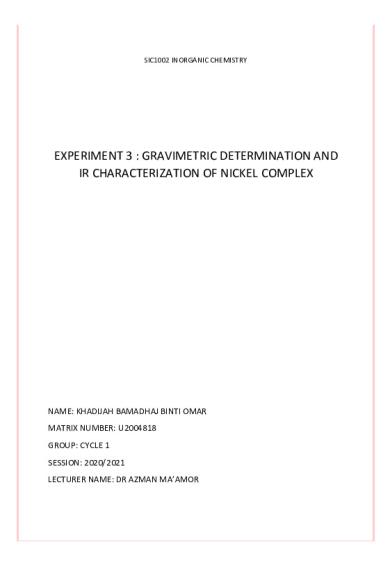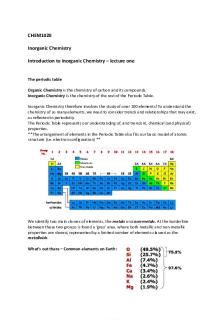Inorganic 1 Labreport U2004 818 EXP3 PDF

| Title | Inorganic 1 Labreport U2004 818 EXP3 |
|---|---|
| Author | Khadijah Bamadhaj |
| Course | Inorganic Chemistry 1 |
| Institution | Universiti Malaya |
| Pages | 8 |
| File Size | 284 KB |
| File Type | |
| Total Downloads | 36 |
| Total Views | 157 |
Summary
sic1002 exp3 lab report...
Description
SIC1002 INORGANIC CHEMISTRY
EXPERIMENT 3 : GRAVIMETRIC DETERMINATION AND IR CHARACTERIZATION OF NICKEL COMPLEX
NAME: KHADIJAH BAMADHAJ BINTI OMAR MATRIX NUMBER: U2004818 GROUP: CYCLE 1 SESSION: 2020/2021 LECTURER NAME: DR AZMAN MA’AMOR
TITLE: GRAVIMETRIC DETERMINATION AND IR CHARACTERIZATION OF NICKEL COMPLEX OBJECTIVES: o o
To understand the concept of gravimetric analysis. Able to derive the mass of nickel calculated from the mass of precipitate.
INTRODUCTION: Gravimetric analysis is one of the most accurate analytical methods available. It is concerned with the determination of a substance by the process of weighing. The element or radical to be determined is converted into a stable compound of definite composition and the mass of the compound is determined accurately. From this, the mass of element or radical is calculated.
The gravimetric analysis involves: a) precipitation b) filtration c) washing of the precipitate d) drying, ignition and weighing of the precipitate
In this experiment, the mass and weight percent of the metal nickel from a solid compound of nickel ammonium sulphate, Ni(C4H7O2N2)2, is determined through gravimetric analysis. Nickel is selectively precipitated from the sample of nickel ammonium sulphate with dimethylglyoxime. The sample, nickel ammonium sulphate, is to be reacted with a chelating agent and precipitating reagent called dimethylglyoxime (DMG) which acts as ligand that binds to the nickel (II) metal ion to form a complex. The prepared compound will be characterized using FTIR (Fourier Transform Infrared Spectroscopy). The FTIR analysis method uses infrared to scan test samples and observe chemical properties. This way chemists able to determine the functional groups in a molecule.
EXPERIMENTAL: PART A 1. 25-mL of a nickel (ii) sulphate solution was added into each two 400-mL beakers using a pipette. 2. About 5-mL of dilute hydrochloric acid (2M) was added and the solution was diluted to 200-mL with distilled water. Later, the solution was heated to 60−80℃. 3. 20-mL of dimethylglyoxime solution (1%) was added to the hot solution, followed by dropwise addition, with stirring of ammonium hydroxide until precipitation occurs and the solution is slightly basic (about 2-mL of excess ammonium hydroxide). The completeness of the precipitation was tested by adding more dimethylglyoxime (1%). 4. The precipitate was warmed for 30 minutes and cooled to room temperature. Then, it
was filtered through a weighed No.4 sintered glass crucible previously dried at 110℃. 5. The precipitate was washed with cold distilled water until it is free from any chloride (test with silver nitrate solution) and dried overnight. 6. The crucible was cooled in a desiccator and was weighed until constant weight was achieved. 7. The concentration (in g/L) of nickel (ii) ions in the solution was calculated from the weight of the precipitate.
PART B Solid FTIR sample preparation. Method 1: as Nujol Mulls. 1. Samples were grounded in a mortar to reduce the average particle size to 1 to 2 microns. 2. About 5 to 10 mg of finely ground sample were then placed onto the face of a KBr plate, a small drop of mineral oil was added, and the second window was placed on top. 3. With a gentle circular and back and forth rubbing motion of the two windows, the mixture was evenly distributed between the plates. When properly prepared, mixture was slightly translucent with no bubbles. 4. The sandwiched plates were placed in the spectrometer to obtain a spectrum. Ideally, the strongest band should have a transmission of 0 to 10% and should not be totally absorbing for more than 20 cm−1.
Method 2: KBr pellets/disks. 1. Some KBr was transferred out of the oven. About 1 to 2% of sample was added, mixed and grounded to a fine powder in mortar with pestle. For very hard samples, the sample was added first, grounded, KBr was then added and then grounded again. The sample must be very finely grounded as in the Nujol mulling technique to reduce scattering losses and absorption band distortions. 2. Enough sample was placed to cover the bottom of the pellet die. 3. Then it was placed in press and pressed at 5000-10000 psi. 4. The pressed sample from die was removed carefully and placed in the FTIR sample holder. The pressed disc was nearly clear when properly made. If found translucent it was reground and repressed.
5. The sample was inserted into the IR sample holder and attached with scotch tape. The spectrum was switched on. RESULTS AND DISCUSSION:
Weight (g) Empty weight (g) Crucible + precipitate (g) Weight of precipitate (g)
1 30.2600 31.2505 0.99050
Average weight of the precipitate, nickel (ii) dimethylglyoximate = (0.99050 + 0.99690) / 2 = 0.99370 g
Moles of nickel (ii) dimethylglyoximate = mass sample / RMM of sample = 0.99370 / 288.9146 = 0.00344 mol
From the equation: Ni2+ + 2C4H8O2N2 → Ni(C4H7O2N2)2 + 2H+
Mol ratio of nickel ion to nickel (ii) dimethylglyoximate = 1:1 Mol of Ni2+ ion = 0.00344 mol Mass of Ni2+ ion = mol / RAM = 0.00344 / 58.6934 = 0.20191 g
Concentration of nickel ion = mass / volume in litres = 0.20191 / 0.025 = 8.0764 g/L Theoretical percentage by mass of nickel in nickel (ii) dimethylglyoximate
2 28.8100 29.8069 0.99690
= (ram Ni / RMM nickel (ii) dimethylglyoximate) / 100% = (58.6934 / 288.9146) / 100% = 20.32% Actual percentage by mass of nickel in nickel (ii) dimethylglyoximate = (mass nickel ion / mass nickel (ii) dimethylglyoximate ) / 100% = (0.20191 / 0.99370) / 100% = 20.32% *theoretical percentage = actual percentage.
Discussions: This experiment involves the reaction between nickel ion and dimethylglyoxime (DMG) to produce nickel (ii) dimethylglyoximate. This compound then produces a red precipitate in the presence of a basic ammoniacal buffer, like ammonium hydroxide. The chelation reaction occurs due to donation of the electron pairs on the four nitrogen atoms, not by electrons on the oxygen atoms.
The reason we utilise DMG for our precipitate is because it is only slightly soluble in water, which is essential in the calculation part of this experiment. It is important to avoid the
addition of excess of the reagent because it may crystallize out with the chelate. The errors from these sources are minimized my maintaining the volume added of the chelating reagent to a small volume. The amount of reagent added is also affected by the presence of other metals such as cobalt, which can form a soluble complex with the reagent. A greater amount of DMG must be added if a high quantity of these ions is present, to ensure all of it precipitates.
The nickel dimethylglyoximate is very bulky in character. Therefore, the sample weight used in the analysis must be carefully controlled to allow more convenient handling of the precipitate during transferral to the filtering crucible. The density of the precipitate is improved by adjusting the pH to 3 or 4, followed by the addition of ammonia solution. A slow increase in the concentration of ammonia in the solution causes the pH to rise slowly and results in the steady precipitation of the complex. The result is the formation of a denser, easily handled precipitate. Once the filtrate has been collected and dried, the nickel content of the solution is calculated stoichiometrically from the weight of the precipitate.
The theoretical percentage by mass of nickel ion in nickel (ii) dimethylglyoximate is equal to that of the actual value. Regarding the results of the spectroscopy, Functional groups present are primary amine, alkane, nitro compound, alkyl, aryl ether, alkene, and alkyl halide.
PRECAUTION STEPS: 1. Always make sure you are wearing a lab coat and safety googles before starting the experiment. 2. Combine reagents in their appropriate order, such as adding about 20 mL of dimethylglyoxime solution (1%) to the hot solution. 3. Use the fume boot to reduce potential exposures. 4. Careful not to press the glass crucible too hard into the Buchner flask as it is fragile.
CONCLUSION: The mass of nickel ions present in this experiment is 0.20191 g. Concentration of nickel ion is 8.0764 g/L. Theoretical percentage by mass of nickel ion in nickel (ii) dimethylglyoximate, 20.32% is equal to that of the actual value.
Regarding the results of the spectroscopy, compound consists of many kinds of functional groups including amines and alkenes.
QUESTIONS: 1. Draw the structural formula of bis(dimethylglyoximato)nickel(ii) and describe the type of hybridization involved.
TYPE OF HYBRIDIZATIONS: Ni is Sp2 hybridized N is Sp2 hybridized C is Sp3 hybridized
2. Explain why the temperature of the solution must be maintained at 60-80 Celsius during the precipitation process. The boiling point of DMG is lower than 80°C, so if the temperature reaches any higher it will evaporate, and this will affect overall precipitation. Also, at higher temperatures, the solution become more acidic because ammonium gas will be released in excess and reduces the basicity of solution. This will also affect the precipitation.
3. Why was the ammonium hydroxide added in the mixture? To prevent the pH of the solution from falling below 5. If the pH does become too low the equilibrium of the above reaction favours the formation of the nickel (II) ion, causing the dissolution of Ni (DMG)2.
4. Why silver nitrate changes to a cloudy solution with the presence of chloride? When silver nitrate reacts with chloride it produces silver chloride which appears as a cloudy solution due to the low solubility of silver chloride.
REFERENCES:
1. vlab.amrita.edu. (2011). Gravimetric Estimation of Nickel. Retrieved 2 April 2021, from https://vlab.amrita.edu/?sub=2&brch=193&sim=348&cnt=1 2. Chem, T. S. U. (2014). The gravimetric determination of nickel. Retrieved 2 April 2021 from https://chemlab.truman.edu/files/2015/07/nickelgrav.pdf 3. Canadian Conservation Institute (CCI). (2018). How to Test for Chloride Ions in Iron Treatment Solutions Using Silver Nitrate. Retrieved 2 April 2021 from https://www.canada.ca/en/conservation-institute/services/conservation-preservationpublications/canadian-conservation-institute-notes/test-chloride-ions-iron-treatment-silvernitrate.html#a3...
Similar Free PDFs

Labreport
- 8 Pages

Labreport Polarization
- 3 Pages

Exp3 F19 Page2 - ghjk
- 1 Pages

CHM260 LAB Report EXP3
- 12 Pages

818 Consignment Agreement
- 4 Pages

Inorganic Chemistry Housecroft
- 987 Pages

CHE5301B-INORGANIC CHEMISTRY.pdf
- 9 Pages

Pharmaceutical Inorganic Chemistry
- 36 Pages

CHEM 225 minilab 23 labreport
- 3 Pages

9701 nos ps 21 - Labreport
- 5 Pages

Inorganic Pharmaceutical Chemistry
- 14 Pages

Inorganic formulation problems
- 6 Pages
Popular Institutions
- Tinajero National High School - Annex
- Politeknik Caltex Riau
- Yokohama City University
- SGT University
- University of Al-Qadisiyah
- Divine Word College of Vigan
- Techniek College Rotterdam
- Universidade de Santiago
- Universiti Teknologi MARA Cawangan Johor Kampus Pasir Gudang
- Poltekkes Kemenkes Yogyakarta
- Baguio City National High School
- Colegio san marcos
- preparatoria uno
- Centro de Bachillerato Tecnológico Industrial y de Servicios No. 107
- Dalian Maritime University
- Quang Trung Secondary School
- Colegio Tecnológico en Informática
- Corporación Regional de Educación Superior
- Grupo CEDVA
- Dar Al Uloom University
- Centro de Estudios Preuniversitarios de la Universidad Nacional de Ingeniería
- 上智大学
- Aakash International School, Nuna Majara
- San Felipe Neri Catholic School
- Kang Chiao International School - New Taipei City
- Misamis Occidental National High School
- Institución Educativa Escuela Normal Juan Ladrilleros
- Kolehiyo ng Pantukan
- Batanes State College
- Instituto Continental
- Sekolah Menengah Kejuruan Kesehatan Kaltara (Tarakan)
- Colegio de La Inmaculada Concepcion - Cebu



